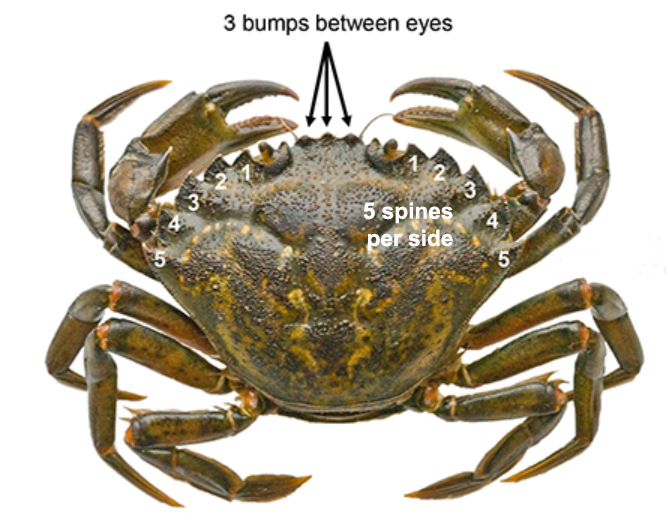How to catch & cook European Green Crab in BC

How to catch & cook European Green Crab
The European Green Crab (Carcinus maenas) is a small coastal crab that is invasive to our shores in the Pacific Northwest. You can help by eating them, because they’re tasty! Cook them into great stock/sauces or harvest them in spring when they’re shells are soft from molting to serve as you would soft shell crab. You can harvest any size of European green crab (up to 75 crabs currently) AND take both male and female unlike native crabs like Dungeness and Red Rock Crab where you can only harvest males of regulation size with a 4 per license limit in BC.
Green Crab can be really damaging to the our coastal ecosystems, devouring native clams, local crabs and disturbing eel grass habitat to name a few major causes for concern. They have a voracious appetite and are really tough little buggers. A female can release up to 185 000 eggs up to twice a year!
European Green Crab ID basics:
- The shell:
- is serrated and pentagon-shaped
- has 3 bumps between their eyes + 5 spines on either side of their eye.
- The back leg tips:
- hairy, pointed, slightly flattened
- Different sized front claws, not black tipped
- Size: up to 10 cm (2-4″ for an adult)
- Color is variable, and not the best characteristic to identify green crab. Green crab can be green, black, or yellow on top of carapace and have white, yellow, orange, or reddish undersides and leg joints.

KEY ID FEATURE
European green crabs have 3 bumps between their eyes and 5 spines on either side of their eye. Dungeness and red rock crab have 9+ spines on each side.
Transport
Don’t transport live green crab if you can avoid it. We don’t want to risk them escaping or spreading to other areas as they can survive out of water for up to 5 days. Even if you think you have seen a European Green Crab, report it, to help control their spread.
Study up, because you have to be able to correctly identify it if you are going to harvest them for food. You don’t want to accidentally confuse them with a native species. Near shore crabs that are green in colour in the Pacific Northwest that could be mistaken for European Green Crab include:
- Northern Kelp Crab (Pugettia producta)
- has a pronounced pointy nose
- has a shell that is longer (front to back) than it is wide
- Helmet Crab, also called Hairy Helmet Crabs (Telmessus cheiragonus), which:
- are covered with bristles and bumps
- has a diamond shaped shell
- Hairy Shore Crab (Hemigrapsus oregonensis), which:
- has three spines on either side of the eyes
- has a square shell
Habitat
Look for the European Green Crab near shore, frequently in shallow waters less than 6 metres. Habitats like salt marshes, sea vegetation(including eelgrass beds), rocky areas, sandy beaches, sheltered areas, shallow water with ocean floor that is sandy, muddy, or pebbled.
Established populations of European Green Crabs have been found on the west coast of Vancouver Island. Since 2018, new signs of European Green Crab have been found on: northern Vancouver Island (Port Hardy); southern Vancouver Island (Esquimalt Lagoon, Witty’s Lagoon); the Gulf Islands (Salt Spring Island); Haida Gwaii and, in southern British Columbian waters (Boundary Bay).

Crab image: Oregon Dept of Fish & Wildlife
#1 Where to go? Check Inaturalist for areas that the green crab has been spotted before. Look for sites of shallow marine estuaries with shore crabs, little neck clams, sculpins, hermit crabs which are good indicator species. Areas with mature red rock or Dungeness crabs are unlikely to contain European green crab.
#2 Get a trap + license. Make sure you use a crab box trap with fine enough mesh that the crabs can’t squeeze out, remember that the carapace (back shell) is 2-4″ wide if you want to trap adults. A folding prawn trap will work as well. Even though green crab isn’t a listed or regulated catch, get a tidal water fishing license for BC, because you’ll be setting traps and the department of fisheries won’t know exactly what you’re trying to catch. Label your traps with your full name and phone number.
#3 Bait – Small fish like herring works or use shellfish (break open the shell)
#4 Timing. Set your traps at low tide in areas under 6m depth and leave for 24 hours for best results retrieving your traps at the next low tide. The Coastal Restoration Society and the Pacific Salmon Foundation are at the forefront of European Green Crab studies. These are some of their great videos that show how to trap them.
#5 Identify your catch – Remove any native crab species and carefully return them to the sea. Correctly identify any European green crab and cook them onsite. Don’t transport live if you can avoid it, we don’t want the problem to spread to other areas as these crabs can survive for 5 days out of water.
#6 How to cook European Green Crab
Flip them on their back and cut them in half to quickly kill the crab, peel the carapace off and add the shell to your pot, remove the gills and discard, then transfer the crab legs/body to a pot with a lid to simmer covered in water for 45 min to make a delicious stock. If you find the crab as a soft shell (if the crab has just molted) then you can fry them up in your favourite combination of oil/spice/garlic/herbs and eat them whole.
